
Sceliphron caementarium, also known as the yellow-legged mud-dauber wasp, black-and-yellow mud dauber, or black-waisted mud-dauber, is a species of sphecid wasp. There are some 30 other species of Sceliphron that occur throughout the world, though in appearance and habits they are quite similar to S. caementarium.

The Australian hornet is not a true hornet, it is a type of potter wasp or "mason wasp", is a vespid native to the Australian states and territories of the Australian Capital Territory, New South Wales, Northern Territory, Victoria, Queensland and Western Australia.
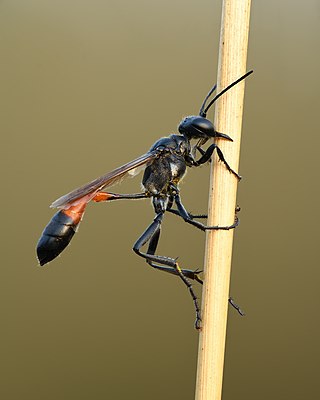
The Sphecidae are a cosmopolitan family of wasps of the suborder Apocrita that includes sand wasps, mud daubers, and other thread-waisted wasps.

Mud dauber is a name commonly applied to a number of wasps from either the family Sphecidae or Crabronidae which build their nests from mud; this excludes members of the family Vespidae, which are instead referred to as "potter wasps". Mud daubers belong to different families and are variable in appearance. Most are long, slender wasps about 1 inch (25 mm) in length. The name refers to the nests that are made by the female wasps, which consist of mud molded into place by the wasp's mandibles. Mud daubers are not normally aggressive, but can become belligerent when threatened. Stings are uncommon.

Sceliphron, also known as black mud daubers or black mud-dauber wasps, is a genus of Hymenoptera of the Sphecidae family of wasps. They are solitary mud daubers and build nests made of mud. Nests are frequently constructed in shaded niches, often just inside of windows or vent openings, and it may take a female only a day to construct a cell requiring dozens of trips carrying mud. Females will add new cells one by one to the nest after each cell is provisioned. They provision these nests with spiders, such as crab spiders, orb-weaver spiders and jumping spiders in particular, as food for the developing larvae. Each mud cell contains one egg and is provided with several prey items. Females of some species lay a modest average of 15 eggs over their whole lifespan. Various parasites attack these nests, including several species of cuckoo wasps, primarily by sneaking into the nest while the resident mud dauber is out foraging.

The organ pipe mud dauber is a predatory wasp in the family Crabronidae. It is fairly large, ranging from 3.9–5.1 cm, and has been recorded to fly from May to September. Females and males are similar in colour, a shiny black, with the end part of the back leg being pale yellow to white. The organ pipe mud dauber feeds mainly on three genera of spider: Neoscona, Araneus, and Eustala. Melittobia, a parasitoid wasp, is a common ectoparasite of T. politum prepupae. Other sources of parasitism include the bombyliid fly Anthrax, chrysidid wasps, and various species of scavenger flies (Miltogramminae). The tufted titmouse is a known predator of T. politum, and may feed on them more commonly than previously thought, as the holes made by the titmouse are similar in shape and size to those made by T. politum leaving the nest after pupation.
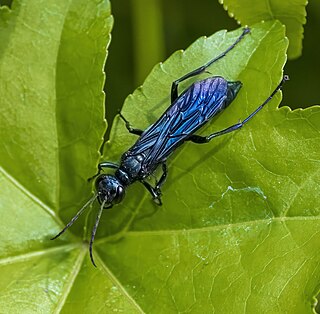
Chalybion californicum, the common blue mud dauber of North America, is a metallic blue species of mud dauber wasp first described by Henri Louis Frédéric de Saussure in 1867. It is not normally aggressive towards humans. It is similar in shape and colour to the steel-blue cricket hunter. Like other types of wasps, males do not have an ovipositor, and therefore cannot sting. It is ranged from northern Mexico to southern Canada, including most of the United States. It has also been introduced to regions including Hawaii, Bermuda, Croatia and other European countries.

A wasp is any insect of the narrow-waisted suborder Apocrita of the order Hymenoptera which is neither a bee nor an ant; this excludes the broad-waisted sawflies (Symphyta), which look somewhat like wasps, but are in a separate suborder. The wasps do not constitute a clade, a complete natural group with a single ancestor, as bees and ants are deeply nested within the wasps, having evolved from wasp ancestors. Wasps that are members of the clade Aculeata can sting their prey.

Sceliphron spirifex is a species of sphecid wasp. It has a medium-sized body, which is dull black with a long, yellow petiole (waist). The legs are black with yellow bands, the antennae are black and the wings are clear.
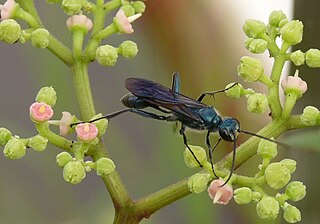
Chalybion is a genus of blue mud dauber wasps in the family Sphecidae. Chalybion species nest in a wide range of natural and artificial cavities such as holes in wood, walls, plant stems, etc., where they typically provision their brood cells with paralyzed spiders. They also reuse old nests of other wasps like Trypoxylon and Sceliphron.

Sceliphron curvatum, also known as the Asian mud-dauber wasp, is an insect in the genus Sceliphron of the wasp family Sphecidae. Like all wasps of this genus, it is a solitary species and builds nests out of mud. S. curvatum is native to some regions of Asia and invasive to Europe.

Hunting wasps are members of various taxa of the insect order Hymenoptera. Their habits and affinities vary in many ways, but all practise parental care of their larvae in that they capture prey, usually insects, to feed their larvae. Whether solitary or social, most species construct some form of protection or nest in which they hide the prey and in which the larvae can feed and pupate in reasonable security.

Sceliphron laetum is a wasp in the family Sphecidae, the mud-dauber wasps. Like other members of this genus, it is a solitary species and builds cells out of mud in which to rear its young, provisioning them with paralysed spiders, and laying an egg in each. This wasp is native to Australia and southeastern Asia.
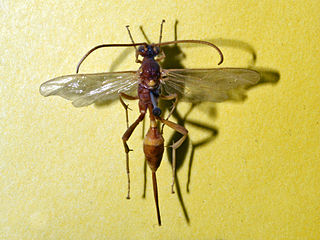
Acroricnus seductor is a species of wasp belonging to the family Ichneumonidae.
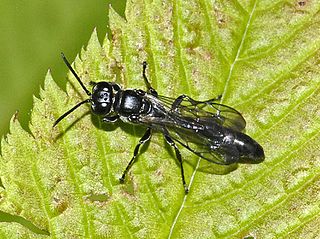
Trypoxylon is a genus of wasps in the family Crabronidae. All Trypoxylon species that have been studied so far are active hunters of spiders, which they paralyse with a venomous sting, to provide as food to their developing larvae. Depending on the species, they will either construct their own nest from mud or find cavities that already exist. These cavities can range from keyholes to nail holes to previously abandoned nests, and are generally sealed with mud to create cells for their larvae.

Pison spinolae, commonly known as mason wasp, is a solitary wasp of the family Crabronidae, found throughout New Zealand.
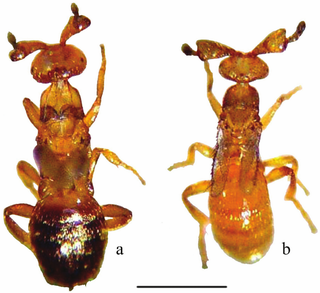
Melittobia australica is a species of chalcid wasp from the family Eulophidae which is a gregarious ecto-parasitoid of acuealate Hymenoptera.

Chrysis angolensis is a species of cuckoo wasp in the family Chrysididae, found throughout much of the world. It has been recently recorded as being introduced to French Polynesia. The species is a parasite of mud dauber nests, especially the black and yellow mud dauber Sceliphron caementarium.

Sceliphron asiaticum is a species of thread-waisted wasp in the family Sphecidae. It is native to the Neotropics, South America and the Caribbean region.

Hylaeus nubilosus is a species of insect within the genus Hylaeus. It is commonly referred to as the cloudy masked bee.


















